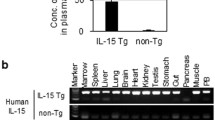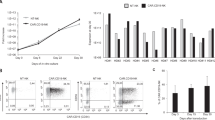Abstract
It is unclear whether autologous immunity could be recruited to restrict the progression of leukemia. Patients harboring leukemia commonly display suppressed cell mediated immunity, which may contribute to their inability to control the disease. Immune response against leukemia is evident in allogeneic HLA-mismatched bone marrow transplantation, implicating the involvement of NK cells. This graft-versus-leukemia (GVL) activity suggests that, if not suppressed, an autologous NK cell response could potentially control acute leukemia that had down-regulated HLA expression. In the current study we assessed the role of non-suppressed autologous NK cells in controlling a syngeneic highly malignant leukemia, the CRNK-16 line, that constitute a major cause of natural death in aged F344 rats. A minuscule dose of 60 CRNK-16 leukemia cells per rat was sufficient to induce 50% mortality rates, and animals that survived this challenge did not show improved survival upon a second challenge. The CRNK-16 line was found to exhibit low levels of MHC-I, and selective in vivo depletion of NK cells nullified in vitro NK activity against the CRNK-16 line and reduced survival rates from this leukemia. In vivo activation of NK cells, employing low doses of poly I-C or IL-12, increased in vitro NK activity against the leukemia and dramatically improved survival rates when treatment was initiated before, but not after leukemia inoculation. These results indicate the ability of competent autologous NK cells to restrict highly malignant non-immunogenic leukemia. Thereby, this model presents an opportunity to study specific in vivo NK-leukemia interactions.










Similar content being viewed by others
References
Lotzova E (1991) Natural killer cells: immunobiology and clinical prospects. Cancer Invest 9:173–184
Pross HF, Lotzova E (1993) Role of natural killer cells in cancer. Nat Immun 12:279–292
Moretta A, Moretta L (1997) HLA class I specific inhibitory receptors. Curr Opin Immunol 9:694–701
Moretta A, Biassoni R, Bottino C, Mingari MC, Moretta L (2000) Natural cytotoxicity receptors that trigger human NK-cell-mediated cytolysis. Immunol Today 21:228–34
Elkins WL, Pickard A, Pierson GR (1984) Deficient expression of class-I HLA in some cases of acute leukemia. Cancer Immunol Immunother 18:91–100
Leung W, Civin CI (2000) Use of purified stem and progenitor cells for transplantation. In: Atkinson EK (ed) Clinical bone marrow and blood stem cell transplantation. Cambridge University Press, Cambridge, pp 1191
Karre K (2002) Immunology. A perfect mismatch. Science 295:2029–2031
Lowdell MW, Craston R, Samuel D, Wood ME, O’Neill E, Saha V, Prentice HG (2002) Evidence that continued remission in patients treated for acute leukaemia is dependent upon autologous natural killer cells. Br J Haematol 117:821–827
Tajima F, Kawatani T, Endo A, Kawasaki H (1996) Natural killer cell activity and cytokine production as prognostic factors in adult acute leukemia. Leukemia 10:478–482
Pawelec G, Da Silva P, Max H, Kalbacher H, Schmidt H, Bruserud O, Zugel U, Baier W, Rehbein A, Pohla H (1995) Relative roles of natural killer- and T cell-mediated anti-leukemia effects in chronic myelogenous leukemia patients treated with interferon-alpha. Leuk Lymphoma 18:471–478
Pierson BA, Miller JS (1996) CD56+bright and CD56+dim natural killer cells in patients with chronic myelogenous leukemia progressively decrease in number, respond less to stimuli that recruit clonogenic natural killer cells, and exhibit decreased proliferation on a per cell basis. Blood 88:2279–2287
Takahashi T, Hirano N, Chiba S, Yazaki Y, Hirai H (2000) Immunogene therapy against mouse leukemia using B7 molecules. Cancer Gene Ther 7:144–150
Rojas R, Roman J, Herrera C, Alvarez MA, Ramirez R, Torres A (2003) BALB/C mice injected with LSTRA leukemic cell line are cured by in vivo treatment with IL-2 + GM-CSF. Leuk Res 27:351–357
Zhang B, Wu KF, Lin YM, Ma XT, Rao Q, Zheng GG, Cao ZY, Li G, Song YH (2004) Gene transfer of pro-IL-18 and IL-1beta converting enzyme cDNA induces potent antitumor effects in L1210 cells. Leukemia 18:817–825
Saudemont A, Buffenoir G, Denys A, Desreumaux P, Jouy N, Hetuin D, Bauters F, Fenaux P, Quesnel B (2002) Gene transfer of CD154 and IL12 cDNA induces an anti-leukemic immunity in a murine model of acute leukemia. Leukemia 16:1637–1644
Reynolds CW, Bere EW Jr, Ward JM (1984) Natural killer activity in the rat. III. Characterization of transplantable large granular lymphocyte (LGL) leukemias in the F344 rat. J Immunol 132:534–540
Ward JM, Reynolds CW (1983) Large granular lymphocyte leukemia. A heterogeneous lymphocytic leukemia in F344 rats. Am J Pathol 111:1–10
Ryan JC, Niemi EC, Nakamura MC (2000) Functional analysis of natural killer cell receptors in the RNK-16 rat leukemic cell line. Methods Mol Biol 121:283–295
Leibson PJ (1997) Signal transduction during natural killer cell activation: inside the mind of a killer. Immunity 6:655–661
Binstadt BA, Brumbaugh KM, Dick CJ, Scharenberg AM, Williams BL, Colonna M, Lanier LL, Kinet JP, Abraham RT, Leibson PJ (1996) Sequential involvement of Lck and SHP-1 with MHC-recognizing receptors on NK cells inhibits FcR-initiated tyrosine kinase activation. Immunity 5:629–638
Burshtyn DN, Scharenberg AM, Wagtmann N, Rajagopalan S, Berrada K, Yi T, Kinet JP, Long EO (1996) Recruitment of tyrosine phosphatase HCP by the killer cell inhibitor receptor. Immunity 4:77–85
Alexopoulou L, Holt AC, Medzhitov R, Flavell RA (2001) Recognition of double-stranded RNA and activation of NF-kappaB by Toll-like receptor 3. Nature 413:732–738
Page GG, McDonald JS, Ben-Eliyahu S (1998) Pre-operative versus postoperative administration of morphine: impact on the neuroendocrine, behavioural, and metastatic-enhancing effects of surgery. Br J Anaesth 81:216–223
Chambers WH, Vujanovic NL, DeLeo AB, Olszowy MW, Herberman RB, Hiserodt JC (1989) Monoclonal antibody to a triggering structure expressed on rat natural killer cells and adherent lymphokine-activated killer cells. J Exp Med 169:1373–1389
van den Brink MR, Hunt LE, Hiserodt JC (1991) In vivo treatment with monoclonal antibody 3.2.3 selectively eliminates natural killer cells in rats. J Exp Med 171:197–210
Fukumoto T, McMaster WR, Williams AF (1982) Mouse monoclonal antibodies against rat major histocompatibility antigens. Two Ia antigens and expression of Ia and class I antigens in rat thymus. Eur J Immunol 12:237–243
Chambers WH, Brumfield AM, Hanley-Yanez K, Lakomy R, Herberman RB, McCaslin DC, Olszowy MW, McCoy JP Jr (1992) Functional heterogeneity between NKR-P1bright/Lycopersicon esculentum lectin (L.E.)bright and NKR-P1bright/L.E.dim subpopulations of rat natural killer cells. J Immunol 148:3658–3665
Ben-Eliyahu S, Page GG (1992) In vivo assessment of natural killer cell activity in rats. Prog Neuroendocrineimmunol 5:199–214
Ben-Eliyahu S, Page GG, Yirmiya R, Taylor AN (1996) Acute alcohol intoxication suppresses natural killer cell activity and promotes tumor metastasis. Nat Med 2:457–460
Rook AH, Wood GS, Yoo EK, Elenitsas R, Kao DM, Sherman ML, Witmer WK, Rockwell KA, Shane RB, Lessin SR, Vonderheid EC (1999) Interleukin-12 therapy of cutaneous T-cell lymphoma induces lesion regression and cytotoxic T-cell responses. Blood 94:902–908
Smyth MJ, Taniguchi M, Street SE (2000) The anti-tumor activity of IL-12: mechanisms of innate immunity that are model and dose dependent. J Immunol 165:2665–2670
van Herpen CM, van der Laak JA, de Vries IJ, van Krieken JH, de Wilde PC, Balvers MG, Adema GJ, De Mulder PH (2005) Intratumoral recombinant human interleukin-12 administration in head and neck squamous cell carcinoma patients modifies locoregional lymph node architecture and induces natural killer cell infiltration in the primary tumor. Clin Cancer Res 11:1899–1909
Michelson AM, Lacour F, Lacour J (1985) Polyadenylic.polyuridylic acid in the cotreatment of cancer. Proc Soc Exp Biol Med 179:1–8
Salazar AM, Levy HB, Ondra S, Kende M, Scherokman B, Brown D, Mena H, Martin N, Schwab K, Donovan D, Dougherty D, Pulliam M, Ippolito M, Graves M, Brown H, Ommaya A (1996) Long-term treatment of malignant gliomas with intramuscularly administered polyinosinic–polycytidylic acid stabilized with polylysine and carboxymethylcellulose: an open pilot study. Neurosurgery 38:1096–1103; discussion 1103–4
Ewel CH, Urba WJ, Kopp WC, Smith JW d, Steis RG, Rossio JL, Longo DL, Jones MJ, Alvord WG, Pinsky CM et al (1992) Polyinosinic–polycytidylic acid complexed with poly-l-lysine and carboxymethylcellulose in combination with interleukin 2 in patients with cancer: clinical and immunological effects. Cancer Res 52:3005–3010
Hovanessian AG, Youn JK, Buffet-Janvresse C, Riviere Y, Michelson M, Lacour J, Lacour F (1985) Enhancement of natural killer cell activity and 2–5A synthetase in operable breast cancer patients treated with polyadenylic; polyuridylic acid. Cancer 55:357–362
Tahara H, Lotze MT (1995) Antitumor effects of interleukin-12 (IL-12): applications for the immunotherapy and gene therapy of cancer. Gene Ther 2:96–106
Avraham R, Schwartz Y, Rosenne E, Melamed R, Ben-Eliyahu S (2004) IL-12-based immunotherapy reduces post-surgery immunosuppression and metastasis, and increases survival from experimental leukemia. Abstract
Slavin S, Ackerstein A, Weiss L, Nagler A, Or R, Naparstek E (1992) Immunotherapy of minimal residual disease by immunocompetent lymphocytes and their activation by cytokines. Cancer Invest 10:221–227
Weiss L, Reich S, Mandelboim O, Slavin S (2004) Murine B-cell leukemia lymphoma (BCL1) cells as a target for NK cell-mediated immunotherapy. Bone Marrow Transplant 33:1137–1141
Melamed R, Rosenne E, Shakhar K, Schwartz Y, Abudarham N, Ben-Eliyahu S (2005) Marginating pulmonary-NK activity and resistance to experimental tumor metastasis: suppression by surgery and the prophylactic use of a beta-adrenergic antagonist and a prostaglandin synthesis inhibitor. Brain Behav Immun 19:114–126
Farag SS, Fehniger TA, Ruggeri L, Velardi A, Caligiuri MA (2002) Natural killer cell receptors: new biology and insights into the graft-versus-leukemia effect. Blood 100:1935–1947
Ruggeri L, Capanni M, Urbani E, Perruccio K, Shlomchik WD, Tosti A, Posati S, Rogaia D, Frassoni F, Aversa F, Martelli MF, Velardi A (2002) Effectiveness of donor natural killer cell alloreactivity in mismatched hematopoietic transplants. Science 295:2097–2100
Pende D, Rivera P, Marcenaro S, Chang CC, Biassoni R, Conte R, Kubin M, Cosman D, Ferrone S, Moretta L, Moretta A (2002) Major histocompatibility complex class I-related chain A and UL16-binding protein expression on tumor cell lines of different histotypes: analysis of tumor susceptibility to NKG2D-dependent natural killer cell cytotoxicity. Cancer Res 62:6178–6186
Fauriat C, Marcenaro E, Sivori S, Rey J, Gastaut JA, Moretta A, Olive D, Costello RT (2003) Natural killer cell-triggering receptors in patients with acute leukaemia. Leuk Lymphoma 44:1683–1689
Yokoyama S, Staunton D, Fisher R, Amiot M, Fortin JJ, Thorley-Lawson DA (1991) Expression of the Blast-1 activation/adhesion molecule and its identification as CD48. J Immunol 146:2192–2000
Author information
Authors and Affiliations
Corresponding author
Rights and permissions
About this article
Cite this article
Avraham, R., Inbar, S., Rosenne, E. et al. Autologous control of a highly malignant syngeneic CRNK-16 leukemia in the rat: a role for NK cells. Cancer Immunol Immunother 55, 1348–1357 (2006). https://doi.org/10.1007/s00262-006-0139-5
Received:
Accepted:
Published:
Issue Date:
DOI: https://doi.org/10.1007/s00262-006-0139-5




